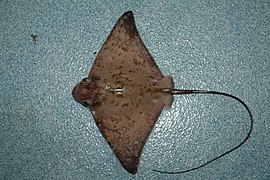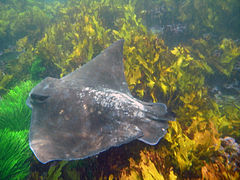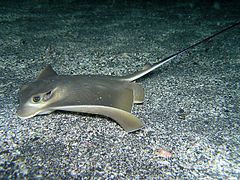Myliobatis
| Myliobatis | |
|---|---|

| |
| Myliobatis californica | |
| Scientific classification | |
| Kingdom: | |
| Phylum: | |
| Class: | |
| Subclass: | |
| Order: | |
| Family: | |
| Genus: | Myliobatis Cuvier, 1816
|
| Species | |
|
See text | |
Myliobatis is a genus of eagle rays in the family Myliobatidae.
Description
Myliobatis species can reach a width of up to about 1.8 m (6 ft).[2] Body consist of a rhomboidal disc, wider than long, with a one dorsal fin. The head is broad and short, with eyes and spiracles on the sides. The tail is slender, with 1-2 large spines at the base, without tail fin.[3]
The teeth are arranged in the lower and upper jaw in flat tooth plates called pavement teeth, each consisting of about 7 series of plates. Said mouth plates are useful to crush clam shells and crustaceans.[3]
Biology
Myliobatis species are ovoviviparous. Their gestation last about 6 months and a female produces 4-7 embryos. Myliobatis species mainly feed on molluscs, bottom-living crustaceans and small fishes.[4]
Habitat
Mylobatis species live in warm, shallow waters. Adults prefer sandy shores while juveniles can usually be encountered offshore.[3][4]
Species
Extant species
There are currently 11 recognized species in this genus:[2][5]
- Myliobatis aquila (Linnaeus, 1758) (Common eagle ray)
- Myliobatis californica T. N. Gill, 1865 (Bat eagle ray)
- Myliobatis chilensis Philippi {Krumweide}, 1893 (Chilean eagle ray)
- Myliobatis freminvillei Lesueur, 1824 (Bullnose eagle ray)
- Myliobatis goodei Garman, 1885 (Southern eagle ray)
- Myliobatis hamlyni J. D. Ogilby, 1911 (Purple eagle ray)[6]
- Myliobatis longirostris Applegate & Fitch, 1964 (Snouted eagle ray)
- Myliobatis peruvianus Garman, 1913 (Peruvian eagle ray)
- Myliobatis ridens Ruocco, Lucifora, Díaz de Astarloa, Mabragaña & Delpiani, 2012 (Shortnose eagle ray)[7]
- Myliobatis tenuicaudatus Hector, 1877 (Australian/New Zealand eagle ray) – M. australis a junior synonym
- Myliobatis tobijei Bleeker, 1854 (Japanese eagle ray)[6]
Extinct species

Extinct species within this genus include:[8]
- †Myliobatis acutus Agassiz, 1843
- †Myliobatis affinis Chapman & Cudmore, 1924
- †Myliobatis albestii Pauca, 1929
- †Myliobatis altavillae Meschinelli, 1924
- †Myliobatis altus Davis, 1888
- †Myliobatis americanus Bravard, 1884
- †Myliobatis angustidens Sismonda, 1849
- †Myliobatis angustus Agassiz, 1843
- †Myliobatis arcuatus Davis, 1888
- †Myliobatis bellardii Issel, 1877
- †Myliobatis bilobatus Dartevelle & Casier, 1943
- †Myliobatis bisulcus Marsh, 1870
- †Myliobatis bothriodon White, 1926
- †Myliobatis canaliculatus Agassiz, 1843
- †Myliobatis colei Agassiz, 1843
- †Myliobatis crassidens Dartevelle & Casier, 1959
- †Myliobatis dimorphus Delfortrie, 1871
- †Myliobatis dispar Leriche, 1913
- †Myliobatis dixoni Agassiz, 1843
- †Myliobatis elatus Stromer, 1905
- †Myliobatis enormis Mendiola, 1999
- †Myliobatis erctensis Salinas, 1901
- †Myliobatis fastigiatus Leidy, 1876
- †Myliobatis fraasi Stromer, 1905
- †Myliobatis frangens Eastman, 1904
- †Myliobatis funiculatus Delfortrie, 1871
- †Myliobatis gigas Cope, 1867
- †Myliobatis girondicus Pedroni, 1844
- †Myliobatis goniopleurus Agassiz, 1843
- †Myliobatis granulosus Issel, 1877
- †Myliobatis haueri Penecke, 1884
- †Myliobatis holmesii Gibbes, 1849
- †Myliobatis intermedius Dartevelle & Casier, 1943
- †Myliobatis kummeli Fowler, 1911
- †Myliobatis lagaillardei Thomas, 1904
- †Myliobatis lateralis Agassiz, 1843
- †Myliobatis leidyi Hay, 1899
- †Myliobatis leognanensis Delfortrie, 1871
- †Myliobatis lepersonnei Dartevelle & Casier, 1959
- †Myliobatis llopisi Bauzá & Gomez Pallerola, 1982
- †Myliobatis magister Leidy, 1876
- †Myliobatis marginalis Agassiz, 1843
- †Myliobatis merriami Jordan & Beal, 1913
- †Myliobatis meyeri Weiler, 1922
- †Myliobatis micropleurus Agassiz, 1843
- †Myliobatis microrhizus Delfortrie, 1871
- †Myliobatis miocenicus Böhm, 1942
- †Myliobatis mokattamensis Stromer, 1905
- †Myliobatis monnieri Cappetta, 1986
- †Myliobatis moorabbinensis Chapman & Pritchard, 1907
- †Myliobatis mordax Leidy, 1876
- †Myliobatis moutai Dartevelle & Casier, 1959
- †Myliobatis nzadinensis Dartevelle & Casier, 1943
- †Myliobatis oweni Agassiz, 1843
- †Myliobatis pachyodon Cope, 1867
- †Myliobatis pachyrhizodus Fowler, 1911
- †Myliobatis pentoni Woodward, 1893
- †Myliobatis placentinus Carraroli, 1897
- †Myliobatis plicatilis Davis, 1888
- †Myliobatis prenticei Chapman & Cudmore, 1924
- †Myliobatis raouxi Arambourg, 1952
- †Myliobatis rima Meyer, 1844
- †Myliobatis rivierei Sauvage, 1878
- †Myliobatis rugosus Leidy, 1855
- †Myliobatis salentinus Botti, 1877
- †Myliobatis semperei Mendiola, 1999
- †Myliobatis sendaicus Hatai, Murata & Masuda, 1965
- †Myliobatis serratus Meyer, 1843
- †Myliobatis sinhaleyus Deraniyagala, 1937
- †Myliobatis stokesii Agassiz, 1843
- †Myliobatis striatus Buckland, 1837
- †Myliobatis strobeli Issel, 1877
- †Myliobatis testae Philippi, 1846
- †Myliobatis tewarii Mishra, 1980
- †Myliobatis toliapicus Agassiz, 1843
- †Myliobatis transversalis Gibbes, 1849
- †Myliobatis tumidens Woodward, 1889
- †Myliobatis undulatus Chaffee, 1939
- †Myliobatis vicomicanus Cope, 1867
- †Myliobatis wurnoensis White, 1934
These eagle rays lived from the Cretaceous to the Quaternary periods (from 70.6 to 0.012 Ma). Fossils of these fishes have been found worldwide.[8]
The extinct species Myliobatis dixoni is known from Tertiary deposits along the Atlantic seaboards of the United States, Brazil, Nigeria, England, and Germany.[8]
Gallery
-
Myliobatis aquila
-
Myliobatis freminvillei
-
Myliobatis tobijei
Bibliography
- Aguiar, A.A.; Gallo, V.; Valentin, J.L. (2004). "Using the size independent discriminant analysis to distinguish the species of Myliobatis Cuvier (Batoidea: Myliobatidae) from Brazil". Zootaxa. 464: 1–7.
- Compagno, L.J.V. (1999): Checklist of living elasmobranchs. A: Hamlett W.C. (ed.) Sharks, skates, and rays: the biology of elasmobranch fishes., The Johns Hopkins University Press: 471-498.
- Garman, S (1913). "The Plagiostomia (Sharks, Skates and Rays)". Memoirs of the Museum of Comparative Zoology. 36: 1–515.
- Gill, T.N. (1865). "Note on the family of myliobatoids, and on a new species of Aetobatis". Annals of the Lyceum of Natural History of New York. 8: 135–138.
- Walker, C. & Ward, D. (1993): - Fossielen: Sesam Natuur Handboeken, Bosch & Keuning, Baarn. ISBN 90-246-4924-2
See also
References
- ^ Sepkoski, J. (2002). "A compendium of fossil marine animal genera (Chondrichthyes entry)". Bulletins of American Paleontology. 364: 560. Archived from the original on 2012-05-10.
{{cite journal}}: Cite has empty unknown parameter:|coauthors=(help); Unknown parameter|deadurl=ignored (|url-status=suggested) (help) - ^ a b Froese, Rainer and Pauly, Daniel, eds. (2017). Species of Myliobatis in FishBase. July 2017 version.
- ^ a b c Discover life
- ^ a b World Register of Marine Species
- ^ White, W.T. (2014). "A revised generic arrangement for the eagle ray family Myliobatidae, with definitions for the valid genera". Zootaxa. 3860 (2): 149–166. doi:10.11646/zootaxa.3860.2.3.
- ^ a b White, W.T.; Kawauchi, J.; Corrigan, S.; Rochel, E.; Naylor, G.J.P. (2015). "Redescription of the eagle rays Myliobatis hamlyni Ogilby, 1911 and M. tobijei Bleeker, 1854 (Myliobatiformes: Myliobatidae) from the East Indo-West Pacific". Zootaxa. 3948 (3): 521–548. doi:10.11646/zootaxa.3948.3.7.
- ^ Ruocco, N.L.; Lucifora, L.O.; de Astarloa, J.M.D.; Mabragaña, E.; Delpiani, S.M. (2012). "Morphology and DNA barcoding reveal a new species of eagle ray from the Southwestern Atlantic: Myliobatis ridens sp. nov. (Chondrichthyes, Myliobatiformes, Myliobatidae)" (PDF). Zoological Studies. 51 (6): 862–873.
- ^ a b c Shark References





